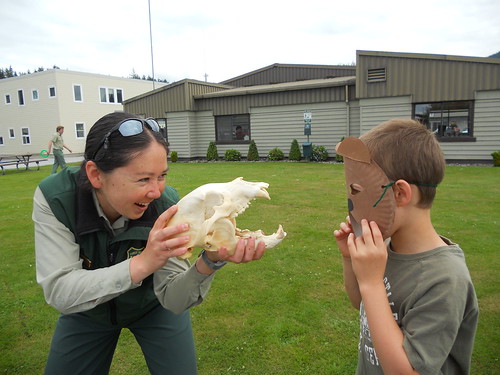
Finding a sense of place is a huge factor in the life of this district interpreter on the world’s largest temperate rainforest - the Tongass National Forest in Alaska.
Corree Seward Delabrue has either lived in or travelled through many of our nation’s states. But Alaska holds the allure of the natural environment that has her fusion of interests: being a natural foods foodie, passionate about working with kids and being committed to community.
Her job includes sharing information about the forest and its education and recreation opportunities with local families, kids and visitors on Wrangell Island where she lives.
“We may have the same kids from week to week participating in our programs so the challenge is to think of something new, fresh and exciting for them,” she said. “I look at creating something with a new spin or look at how one place can change throughout the year with the seasons.”
She’s met success by developing programs that build on themselves and that demonstrate how nature changes over time. She knows a program worked when two weeks later the kids are still talking about it.
Sharing information with tourists is also part of her job.
“Wrangell is a niche market for the small cruise ships, so I work with the town’s visitor center where I meet a lot of people seeking to understand and appreciate the beauty they’ve come to find,” she said. “I explain the Forest Service role in managing the resources here and how we can help people. As an interpreter one of my goals is inspiration. I want people to realize why the Tongass is a special place.”
In the summer, you’ll find her planning Forest Service-led hikes and a weekly Friday night campfire program at the Nemo campgrounds, which may include local experts or visiting Forest Service employees who offer talks. One year, a traditional foods expert sparked Delabrue’s interest in gathering edible items from the forest. One example included spruce tips, which are the tree’s soft, edible spring growth.
“You can candy the tips or boil them to make tea, as the Russians used to do to prevent scurvy,” she said. “You can also add sugar and make it into a jelly or syrup, which I plan to try this year.”
Forest visitors are reminded that permits are required before foraging for forest products.
Delabrue is one of more than 35,000 employees who ensure the health of the nation’s 193 million acres of national forests and grasslands. She was recently spotlighted in Faces of the Forest, a periodic Forest Service web feature which showcases the people, places and professions within the agency.


